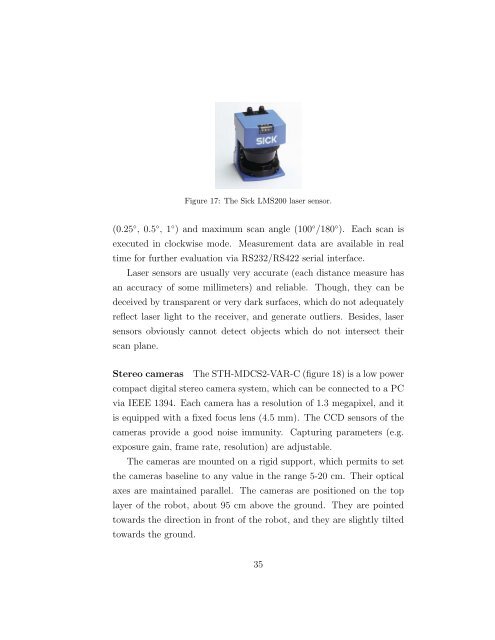Scarica (PDF – 6.19 MB)
Scarica (PDF – 6.19 MB)
Scarica (PDF – 6.19 MB)
Create successful ePaper yourself
Turn your PDF publications into a flip-book with our unique Google optimized e-Paper software.
Figure 17: The Sick LMS200 laser sensor.<br />
(0.25 ◦ , 0.5 ◦ , 1 ◦ ) and maximum scan angle (100 ◦ /180 ◦ ). Each scan is<br />
executed in clockwise mode. Measurement data are available in real<br />
time for further evaluation via RS232/RS422 serial interface.<br />
Laser sensors are usually very accurate (each distance measure has<br />
an accuracy of some millimeters) and reliable. Though, they can be<br />
deceived by transparent or very dark surfaces, which do not adequately<br />
reflect laser light to the receiver, and generate outliers. Besides, laser<br />
sensors obviously cannot detect objects which do not intersect their<br />
scan plane.<br />
Stereo cameras The STH-MDCS2-VAR-C (figure 18) is a low power<br />
compact digital stereo camera system, which can be connected to a PC<br />
via IEEE 1394. Each camera has a resolution of 1.3 megapixel, and it<br />
is equipped with a fixed focus lens (4.5 mm). The CCD sensors of the<br />
cameras provide a good noise immunity. Capturing parameters (e.g.<br />
exposure gain, frame rate, resolution) are adjustable.<br />
The cameras are mounted on a rigid support, which permits to set<br />
the cameras baseline to any value in the range 5-20 cm. Their optical<br />
axes are maintained parallel. The cameras are positioned on the top<br />
layer of the robot, about 95 cm above the ground. They are pointed<br />
towards the direction in front of the robot, and they are slightly tilted<br />
towards the ground.<br />
35




